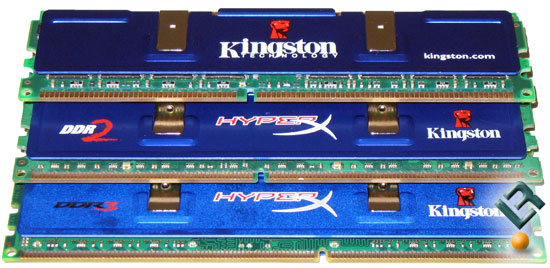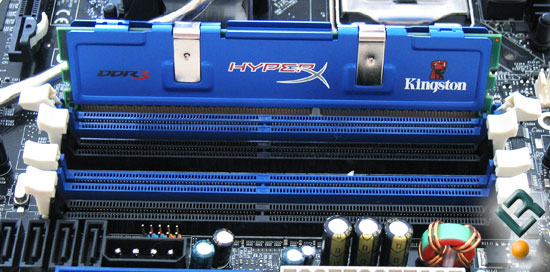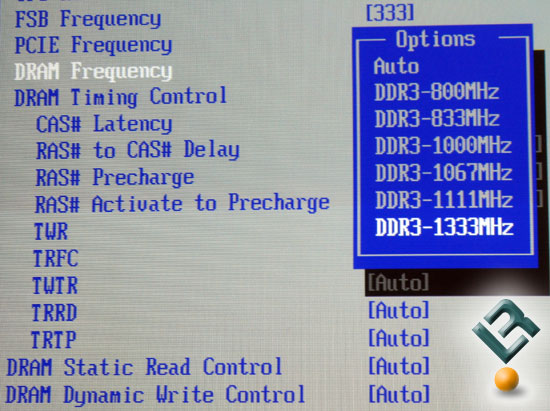Getting To Know DDR3 Memory Modules
DDR3 Memory Modules Ready To Launch This Month
Later this month Intel Bearlake P35 based desktop motherboards will be released for the very first time. While these motherboards will feature the latest and greatest Intel P35 chipsets they also happen to be the first desktop platform that utilizes DDR3 memory modules. For those that don’t know DDR3 is the next generation of Double Data Rate (DDR) Synchronous Dynamic Random Access Memory (SDRAM). DDR3 memory modules are an improvement of DDR and DDR2 memory technology and will deliver higher clock frequencies, lower power consumption and as a result lower heat dissipation. When DDR3 is launched the frequencies will be at 1066Mhz and 1333Mhz, with 1600MHz and beyond out in the distance.
For those that recall the transition from DDR1 to DDR2, the move from DDR2 to DDR3 will be much the same. It will take years for DDR3 to become main stream with many predicting that it will take the industry till 2009 to fully moved over to the new memory form factor. Those with DDR2 motherboard have nothing to worry about as DDR2 production will continue with improved parts still on the drawing boards.

Pictured above are the three generations of Kingston HyperX DDR memory modules. At the very top is a Kingston HyperX DDR1 modules with a DDR2 module directly below it and the upcoming DDR3 module at the very bottom. While all of the modules are the same length notice that the ‘module key’ that is located near the center of each module is in a different location making each generation physically incompatible. It should be noted that DDR3 DIMMS have 240 pins, which the same number as DDR2.

To better show that the 240-pin DDR3 module can not and will not fit in a 240-pin DDR2 socket we took a picture of the Kingston HyperX DDR3 module in a DDR2 socket. As it can be seen in the above picture using the eVGA 680i SLI motherboard as the test bed, the socket key does not line up with the DDR3 memory module key. Even if the modules would fit the power requirements vary between each series. The upcoming DDR3 modules use just 1.5V, compared to DDR2’s 1.8V and DDR’s 2.5V. It seems that many of the 1066MHz and 1333MHz DDR3 modules will need 1.7V to operate at those frequencies, which is still much lower than what we are seeing DDR2 using at the same frequencies. With enthusiast and gamer oriented DDR3 modules starting off at 1333MHz and reaching above 2000MHz in the months ahead voltages will continue to increase from 1.7V.
With upcoming 333MHz FSB processors running DDR3 memory modules at 1333MHz will be a standard setting in the BIOS. To hit 1600MHz a FSB of 400MHz needs to be reached, but that is not tough to do as it would be a mild overclock. DDR2 memory modules on the market right now have been topping off around ~1320MHz, so DDR3 is starting off at the upper limits of where DDR2 starts to become unstable.

When it comes to performance for enthusiasts and gamers it seems the DDR3 kit that you should hold out for is the DDR3 1333MHz memory kits. It seems that DDR3 memory kits start to strut their stuff at speeds above this, so don’t expect to see impressive performance numbers beyond till modules reach this frequency and beyond. From what we can tell not too many modules can even hit 1500MHz with good yields. It seems that the memory companies are still sorting all the memory IC’s and are in the mist of figuring out if Micron, Eplida or Qimonda IC’s are the best to use. It seems that Samsung IC’s aren’t doing too hot, so don’t expect to see those on many of the first enthusiast modules.
When it comes to memory timings the initial 2GB kits of DDR3 1066MHz memory modules are mainly using 6-5-5-15 timings and the 1333MHz modules are running 7-7-7-20 timings. Once again it seems ‘aggressive’ timings is a thing for the past as when DDR2 first came out CL5 and CL6 parts were seen out at about in the early days. While many will baulk at the high timings keep in mind that DDR3 has 8-bit pre-fetch architecture (compared to 4-bit pre-fetch buffer with DDR2 and 2-bit on DDR1), on-die termination (ODT), power-saving modes known as PASR (partial array self refresh) and ASR (auto self refresh) and other capabilities. With the improved pre-fetch architecture alone it makes it hard to compare DDR3 to DDR2 when it comes to timings as the modules do more per cycle.
Love it or hate it, numerous brands of DDR3 memory and Intel Bearlake (P35) chipsets are built, packaged and ready to be placed for sale in the weeks ahead. The question now is who will have the first dual channel 2GHz memory module?

Comments are closed.